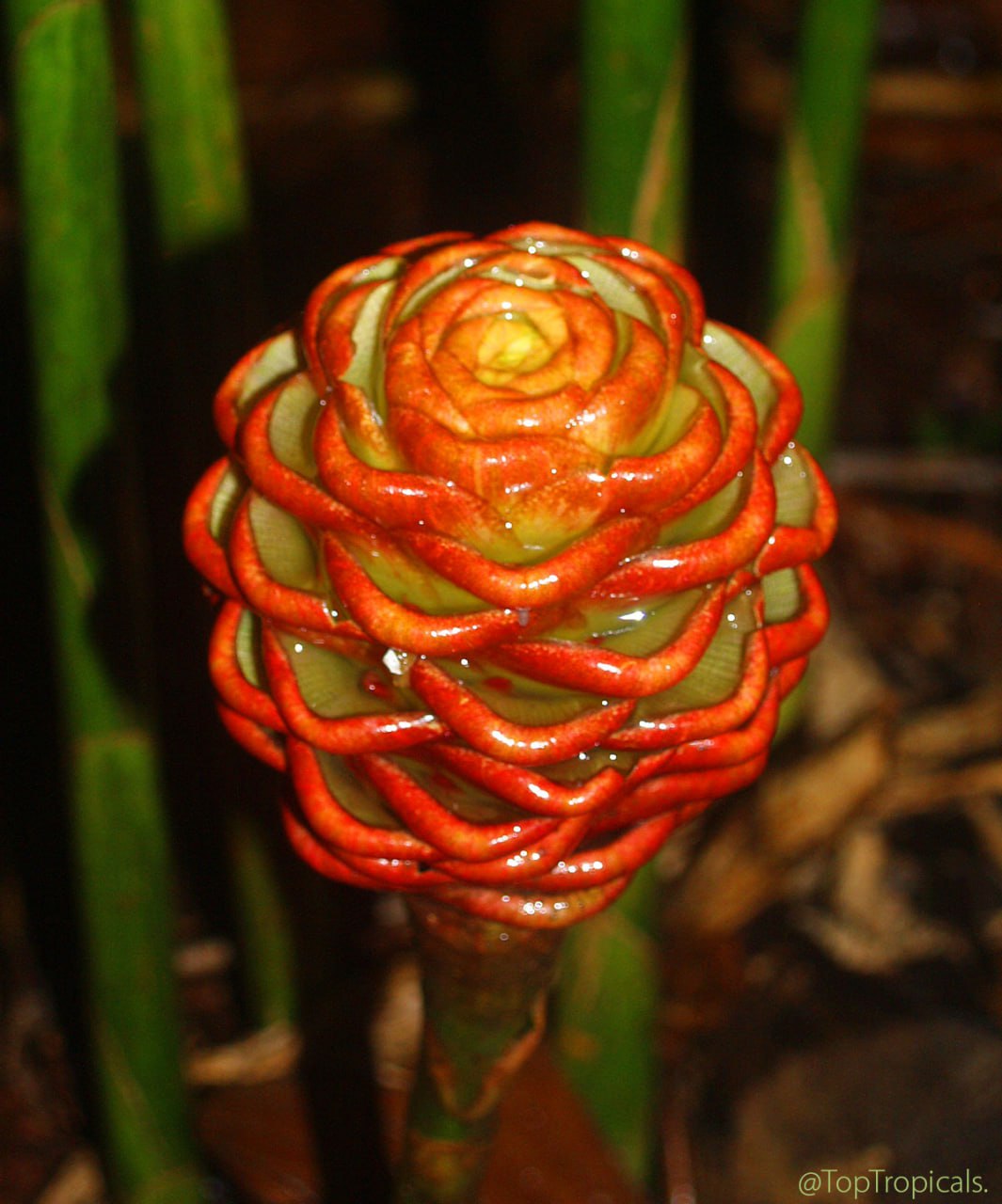Garden Blog - Top Tropicals
How to overwinter the tropical Bird of Paradise

Strelitzia reginae - the Bird of Paradise, bug plant
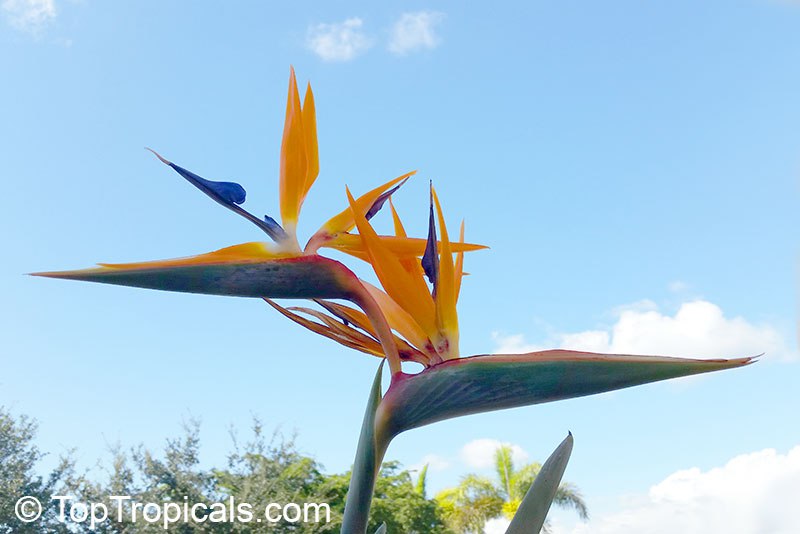
Strelitzia reginae - the Bird of Paradise, flower
❄️ How to overwinter the tropical Bird of Paradise
When frost threatens, water the soil thoroughly a day before - moist soil retains heat better than dry. Cover the plant overnight with frost cloth or breathable fabric, not plastic, to trap ground warmth. For large clumps, wrap the base with mulch or straw to protect rhizomes. After cold events, remove damaged leaves but wait until spring to cut deeply, as live tissue below may still recover.
📚 Learn more:
How to grow Bird of Paradise
🛒 Plant Bird of Paradise
#How_to #Container_Garden
🟢 Join 👉 TopTropicals
- Strelitzia reginae - the Bird of Paradise is a resilient tropical that can adapt to indoor conditions through winter if given bright light, moderate warmth, and careful watering. With a few preventive steps and timely protection, plants will stay healthy and reward you with vigorous new growth and blooms when warmth returns.
- When should you move plants indoors?
- What is the right location for a Bird of Paradise in winter, and why?
- Do you need to do anything before moving them indoors?
- Do plants need watering or feeding during winter?
- Can you overwinter Birds of Paradise outdoors?
- What tips do you have for protecting plants outdoors?
Move Bird of Paradise indoors before nighttime temperatures consistently drop below 55F. Extended exposure to cooler air can slow growth and stress the plant. In central and south Florida, this often means late fall; in cooler zones, aim for early to mid-October. Once temperatures fall below 50F, leaf damage and root stress can occur.
Place the plant in the brightest spot available - ideally near a south- or west-facing window. Strelitzia reginae is light-hungry even during dormancy. Low light leads to leaf yellowing, weak petioles, and slowed recovery in spring. If natural light is limited, supplement with a full-spectrum grow light set 12-18 inches above the foliage for 12-14 hours daily. Maintain room temperatures between 65F and 75F.
Inspect the plant for pests such as mealybugs, scale, and spider mites, which often hide in leaf bases. Rinse the leaves and petioles thoroughly and check the soil surface for insects or snails. Prune off any damaged or aging leaves. If the plant has spent the summer in heavy rain, allow the soil to dry slightly before bringing it indoors to avoid fungus gnats or root issues.
Reduce watering. Indoors, the Bird of Paradise grows slowly in lower light, and excess moisture can cause root rot. Let the top 1-2 inches of soil dry before watering again. Avoid fertilizing during winter rest; resume feeding in spring when new growth appears. If the air indoors is very dry, increase humidity with a pebble tray or humidifier rather than overwatering.
In frost-free areas of Florida (USDA zones 10-11), they can remain outdoors year-round. In zone 9, occasional cold snaps require protection. Mature clumps tolerate brief dips to about 30°F, but foliage burns easily at low temperatures.
When frost threatens, water the soil thoroughly a day before - moist soil retains heat better than dry. Cover the plant overnight with frost cloth or breathable fabric, not plastic, to trap ground warmth. For large clumps, wrap the base with mulch or straw to protect rhizomes. After cold events, remove damaged leaves but wait until spring to cut deeply, as live tissue below may still recover.
📚 Learn more:
How to grow Bird of Paradise
🛒 Plant Bird of Paradise
#How_to #Container_Garden
🟢 Join 👉 TopTropicals
When the Goldfish blooms
Columnea Melissa - Flying Goldfish Plant
🐟 When the Goldfish blooms...
🛒 Add showy Flying Goldfish Plant to your collection
📚 Learn more:
#Container_Garden
🟢 Join 👉 TopTropicals
- 🐡 If you’ve never seen a Columnea Melissa - Flying Goldfish Plant in full bloom, get ready for a surprise. Columnea Melissa is one of those houseplants that looks almost too whimsical to be real. Its bright orange flowers pop out along long, velvety stems, and every single one looks like a tiny goldfish with wings. When the plant starts cascading, it really does look like a whole school of flying fish drifting through the air.
- 🐡 This plant comes from tropical cloud forests, so it loves humidity, gentle light, and steady moisture. An airy mix, a hanging basket, and a bright window are all it really asks for. Cooler winter temps are fine, just keep watering on the light side.
- 🐡 Give it a kitchen or bathroom windowsill and it will reward you with nonstop color. It’s one of those plants that visitors always point at and say… okay, what is THAT?
🛒 Add showy Flying Goldfish Plant to your collection
📚 Learn more:
- ▫️The most colorful houseplant
- ▫️This goldfish lives in a pot and Why is it called Gold Fish Plant
- ▫️Six colorful plants for your indoor garden
#Container_Garden
🟢 Join 👉 TopTropicals
This giant red stared right back at me
Disocactus ackermanni, Red Orchid Cactus, Jungle Cactus
👹 This giant red stared right back at me
🛒 Add Red Orchid Cactus to your collection
📚 Learn more:
Red Orchid Cactus puts out the biggest bloom show
More epiphytic jungle cacti:
Epiphyllum oxypetalum - Queen of the Night
Pseudorhipsalis (Wittia) amazonica - Blue Flame
Epiphyllum guatemalense Monstrosa - Orchid Cactus, Curly Locks
#Container_Garden #Shade_Garden #Nature_Wonders
🟢 Join 👉 TopTropicals
- 🌺 Disocactus ackermanni, also called the Red Orchid Cactus, or Jungle Cactus - is one of those plants that surprises you even when you already know it well. It grows like a tropical fern, with flat, leaflike stems that hang and drape from a basket. Most of the year it looks calm and green. Then, without much warning, it opens a single huge, bright red flower that can reach up to 6 inches wide. The color is intense, almost glowing, and the bloom only lasts a short time, which makes it even more special.
- 🌺 Despite being a cactus, it behaves nothing like a desert plant. This species is native to the tropical forests of Mexico, where it grows as an epiphyte in trees. It prefers shade or filtered light, and it enjoys regular watering. No spines, no trouble, just a very unusual growth habit and a spectacular bloom.
- 🌺 The plant usually flowers from spring through summer, sometimes offering more than one flush. When it does, it always steals attention, and it is one of those plants visitors immediately point at and ask about. This makes it a favorite among collectors of epiphytic cacti and unusual hanging plants.
- 🌺 If you grow it in a hanging basket and give it bright shade, humidity, and consistent moisture, it rewards you with one of the most striking red flowers you will ever see!
🛒 Add Red Orchid Cactus to your collection
📚 Learn more:
Red Orchid Cactus puts out the biggest bloom show
More epiphytic jungle cacti:
Epiphyllum oxypetalum - Queen of the Night
Pseudorhipsalis (Wittia) amazonica - Blue Flame
Epiphyllum guatemalense Monstrosa - Orchid Cactus, Curly Locks
#Container_Garden #Shade_Garden #Nature_Wonders
🟢 Join 👉 TopTropicals
Youll never guess what flower it is!
Golden Rain - variegated Tabernaemontana
👀 You’ll never guess what flower it is!
Because it’s rare. Because it smells amazing. Because those leaves look like they’ve been brushed with sunlight. Golden Rain is one of those plants that makes everyone stop and ask, "What is THAT?"
🛒 Get your own Golden Rain before it's gone
#Perfume_Plants #Hedges_with_benefits #Container_Garden
🟢 Join 👉 TopTropicals
- ✨ If you think you’ve seen every tropical shrub out there, meet Golden Rain - a rare variegated Tabernaemontana that instantly steals the show.
- ✨ What makes it special:
- ✨ How to grow it:
- ✨ Why you’ll love it:
The leaves are a work of art – green with golden or silvery streaks that shimmer in sunlight. The white, fragrant flowers appear in clusters, adding perfume to its beauty. Compact and rounded, it’s perfect for containers or small gardens. And it’s flexible too – thriving in both full sun and partial shade.
Give it bright light, well-draining soil, and regular watering with brief drying between. It’s tropical-friendly, so protect it from frost. In zones 9 and up, it’s easy to grow outdoors. Place it somewhere visible – the golden foliage deserves attention.
Because it’s rare. Because it smells amazing. Because those leaves look like they’ve been brushed with sunlight. Golden Rain is one of those plants that makes everyone stop and ask, "What is THAT?"
🛒 Get your own Golden Rain before it's gone
#Perfume_Plants #Hedges_with_benefits #Container_Garden
🟢 Join 👉 TopTropicals
It smells like bananas but its a magnolia!
Magnolia figo, Banana Magnolia
🍌 It smells like bananas… but it’s a magnolia!
🌸 Magnolia figo, or Banana Magnolia - is in bloom! It is now filling the air with its unbelievably sweet fragrance! Its creamy, cup-shaped flowers smell like fresh bananas mixed with fine perfume - you have to smell it to believe it.
🌸 This compact evergreen shrub grows only about 5-6 ft in a container, making it perfect for small gardens, patios, or even near an entryway where you can enjoy the scent up close. Glossy green leaves, elegant shape, and that irresistible aroma - it’s pure charm in a pot.
🌸 Cold tolerant, heat tolerant, sun or shade - this little magnolia doesn’t ask for much but gives so much back.
🛒 Plant Banana Magnolia
📚 Learn more:
#Perfume_Plants #Container_Garden #Trees
🟢 Join 👉 TopTropicals
🛒 Plant Banana Magnolia
📚 Learn more:
#Perfume_Plants #Container_Garden #Trees
🟢 Join 👉 TopTropicals
The vine with square stems that heals bones and turns heads
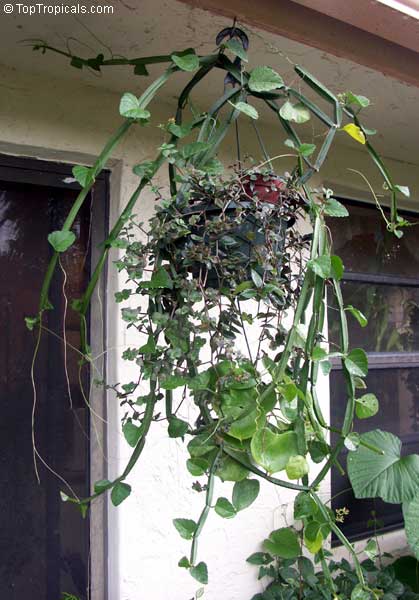
Cissus quadrangularis - Veld Grape, hanging basket
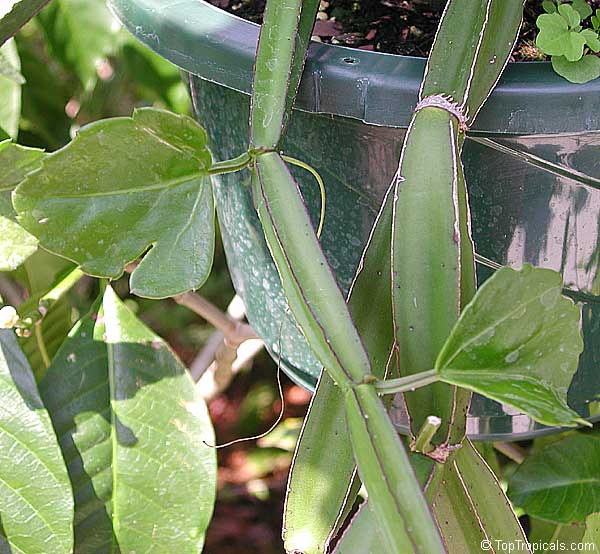
Cissus quadrangularis - Veld Grape, stems

Cissus quadrangularis - Veld Grape plant
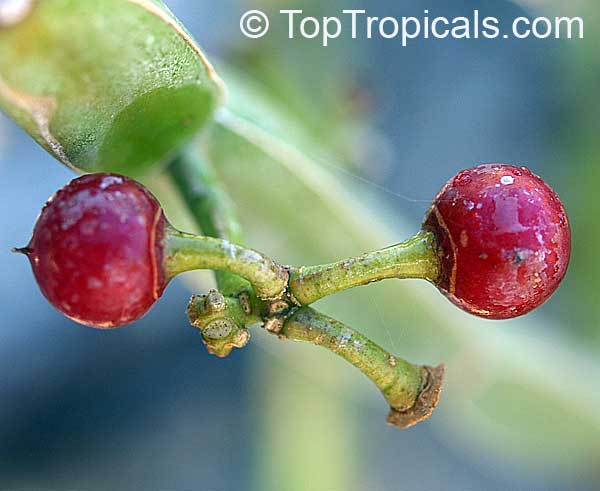
Cissus quadrangularis - Veld Grape, fruit
The vine with square stems that heals bones and turns heads
🛒 Get your own Veld Grape show stopper
#Container_Garden #Remedies #Fun_Facts
🟢 Join 👉 TopTropicals
- Cissus quadrangularis - Veld Grape. This plant is anything but ordinary! It has four-winged stems – square, chunky, and unlike anything else in your garden. Each stem looks like a little green sculpture, with ribs running down the sides. It’s technically a vine, but behaves like a succulent, with thick, juicy stems and tiny tendrils that climb or spill from a pot.
- Native to Africa and India, veld grape thrives on sunshine, heat, and a bit of neglect. Perfect for hanging baskets or as a quirky groundcover. Just give it some light and occasional water, and it’ll keep growing strong.
- It’s also famous as a traditional "bone-healing" herb, earning it the nickname Bone setter plant. But even if you don’t use it for that, it’s a total show-stopper for anyone who loves plants with personality.
- A true show-stopper for collectors and anyone who loves the strange and beautiful side of nature.
🛒 Get your own Veld Grape show stopper
#Container_Garden #Remedies #Fun_Facts
🟢 Join 👉 TopTropicals
Do you have Shampoo Ginger in your garden?
💄 Do you have Shampoo Ginger in your garden?
💄Pine Cone Ginger (Zingiber Zerumbet), is called Shampoo Ginger due to its unique, milky substance found in the cones. If you squeeze these bright red cones, a fragrant, milky liquid seeps out - traditionally used in Asia and Hawaii as a natural shampoo. Even today, you’ll find it in commercial shampoos.
🛒 Grow your own Natural Shampoo Ginger
📚 Learn more:
#Shade_Garden #Container_Garden #Remedies #Fun_Facts
🟢 Join 👉 TopTropicals
💄Pine Cone Ginger (Zingiber Zerumbet), is called Shampoo Ginger due to its unique, milky substance found in the cones. If you squeeze these bright red cones, a fragrant, milky liquid seeps out - traditionally used in Asia and Hawaii as a natural shampoo. Even today, you’ll find it in commercial shampoos.
🛒 Grow your own Natural Shampoo Ginger
📚 Learn more:
- 🟡 Free natural shampoo: squeeze it and see what comes out!
- 🟡 What Ginger makes a natural shampoo?
- 🟡5 most spectacular Ginger species
#Shade_Garden #Container_Garden #Remedies #Fun_Facts
🟢 Join 👉 TopTropicals
Tacca wants to be a cat! And everyone loves cats!
🐈⬛ Tacca wants to be a cat! And everyone loves cats!
That’s probably the real evolutionary secret no botanist will admit! Those whiskers? Pure marketing genius from nature.
Cats had it figured out first — look mysterious, add long elegant whiskers, and everyone falls in love.
Tacca just took notes and said, “Alright, I can work with that!”
So now we have a tropical plant that looks half orchid, half bat, and just enough cat to make people stop, smile, and want one for their collection!
Tacca nivea - White Tacca
Tacca chantrieri - Black Tacca
Tacca leontopetaloides - Green Tacca
📚 Learn more:
🛒 Add Taccas - Bat Lilies to your collection
#Container_Garden #Shade_Garden #Nature_Wonders
🟢 Join 👉 TopTropicals
That’s probably the real evolutionary secret no botanist will admit! Those whiskers? Pure marketing genius from nature.
Cats had it figured out first — look mysterious, add long elegant whiskers, and everyone falls in love.
Tacca just took notes and said, “Alright, I can work with that!”
So now we have a tropical plant that looks half orchid, half bat, and just enough cat to make people stop, smile, and want one for their collection!
Tacca is also called the Bat Lily or Devil Flower. This tropical wonder grows bat-shaped wings and foot-long whiskers. The black form (Tacca chantrieri) looks straight out of a gothic dream, while the white one (Tacca nivea) is ghost-like and elegant.
Some of our plants are blooming right now in the nursery — true Halloween magic! Blooms are delicate and may not travel, but the plants are strong and will flower again soon in your care.
Tacca colors: Black, White, Green:
Tacca nivea - White Tacca
Tacca chantrieri - Black Tacca
Tacca leontopetaloides - Green Tacca
📚 Learn more:
- ▫️The mystery of the White Bat Lily - the plant with wings and whiskers
- ▫️ A flying bat with whiskers
- ▫️ The rarest Green Tacca - Tacca leontopetaloides
- ▫️ When Bat Head Devil Flower is in bloom
- ▫️ Bat Head - Devil Flower
🛒 Add Taccas - Bat Lilies to your collection
#Container_Garden #Shade_Garden #Nature_Wonders
🟢 Join 👉 TopTropicals
Before you open a bottle of wine,
Jaboticaba (Myrciaria cauliflora)
🍷Before you open a bottle of wine, meet the Secret Wine Tree from Brazil
🛒 Grow your own wine from Jaboticaba Tree
📚 Learn more:
🎥 From our customer: video about a mail ordered Jaboticaba tree
#Food_Forest #Nature_Wonders #Container_Garden
🟢 Join 👉 TopTropicals
- 🍷Jaboticaba (Myrciaria cauliflora) grows grapes right on its trunk! It's one of Brazil’s most fascinating and beloved native fruits. Its name alone sounds exotic, but wait until you see it in fruit: shiny, grape-like berries bursting straight from the bark!
- 🍷 Jaboticaba is the source of the famous Brazilian wine Vinho Tinto de Jabuticaba. The fruits are small, dark purple, with a thick skin and a sweet, melting pulp that tastes a lot like black currant. They can be eaten fresh, made into jams, or fermented into homemade wine with an incredible aroma and rich color.
- 🍷 Jaboticaba tree is slow-growing and compact, often used as a bonsai because of its small leaves and graceful shape. But patience pays off - mature trees covered in purple fruits are absolutely stunning! The fruiting habit, called cauliflory, means the fruits grow directly from the trunk and main branches, creating a truly one-of-a-kind look.
- 🍷 Jaboticaba trees can handle some cold (down to mid-20's once mature), don't mind wet rainy seasons and can be grown in containers in cooler areas. They make beautiful landscape trees and conversation starters wherever they’re planted.
- 🍷 If you've ever dreamed of making your own wine from fruit grown in your backyard, this is the tree for you. Jaboticaba isn’t just a plant - it's an experience, a piece of Brazil's culture, and a living work of art that rewards patience with magic.
🛒 Grow your own wine from Jaboticaba Tree
📚 Learn more:
- ▫️What does Blue Jaboticaba taste like?
- ▫️How Blue Jaboticaba is different from regular Jaboticaba?
- ▫️What is Jaboticaba? I like the sound of this word!
- ▫️What is Cauliflory?
🎥 From our customer: video about a mail ordered Jaboticaba tree
#Food_Forest #Nature_Wonders #Container_Garden
🟢 Join 👉 TopTropicals
Weird cactus looks like pasta with Dragon Fruit
Epiphyllum guatemalense Monstrosa - Curly Locks or Orchid Cactus
👀 Weird cactus looks like pasta with Dragon Fruit
🛒 Add Curly Locks to your rare plant collection
📚 Learn more:
Botanical bedhead: curly, crazy, and full of surprises
#Fun_Facts #Container_Garden #Shade_Garden #Nature_Wonders
🟢 Join 👉 TopTropicals
- ➰ Epiphyllum guatemalense Monstrosa - Curly Locks or Orchid Cactus - is one of the most unusual jungle cacti you can grow. Instead of the usual flat cactus leaves, this one grows curly, looping stems that twist and spiral in every direction. It looks like a green waterfall of botanical noodles, perfect for a hanging basket or a high shelf where its wild shape can really show off.
- ➰Curly Locks is actually a natural mutation of a Guatemalan jungle cactus that grows high up in jungle trees, using its stems to absorb moisture and light from the air. Like many epiphytic cacti, it produces large, fragrant flowers that open at night and look strikingly similar to orchids. After blooming, it forms small, oval pink fruits that are edible and juicy - like tiny dragon fruits!
- ➰This plant is self-pollinating, so you don’t need insects or hand pollination to get fruit. It thrives in bright, indirect light and prefers to be a bit root-bound to trigger blooming. Just water moderately, let the soil dry slightly between waterings, and avoid moving it too often once it’s happy in its spot.
- ➰Epiphyllum Curly Locks is not your typical cactus - it’s a living sculpture, a conversation piece, and a fruiting wonder all in one.
🛒 Add Curly Locks to your rare plant collection
📚 Learn more:
Botanical bedhead: curly, crazy, and full of surprises
#Fun_Facts #Container_Garden #Shade_Garden #Nature_Wonders
🟢 Join 👉 TopTropicals
